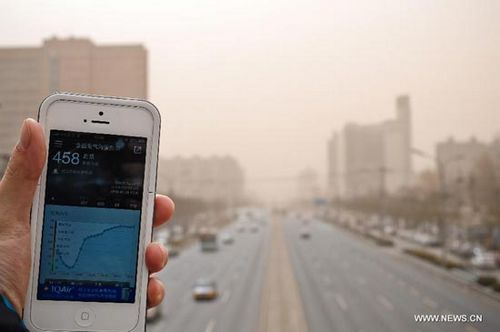
A software on a cell phone shows heavy air pollution in Beijing, capital of China, at 10 a.m. on Feb. 28, 2013. A cold front blew away fog and smog which hit Beijing on Feb. 28 morning, but brought dust and sand from Mongolia and north China's Inner Mongolia Autonomous Region. (Xinhua/Zhang Cheng)
Dense fog and sandstorm hit Beijing again on the morning of Feb. 28, and several monitoring stations rated the air quality that day as "severely polluted."
The reading of PM10, particulates measuring less than 10 micrometers in diameter, reached nearly 1,000 micrograms per cubic meter at 10 a.m. on Feb. 28 in western Beijing, according to monitoring data from the Beijing Municipal Bureau of Environmental Protection. As previous pollutants continue to exist and amass, the city is now suffering from serious air pollution.
"It is terrible to experience fog, haze, and the dust storm at the same time," many residents are worried that such a weather event may happen frequently.
" Fog, haze, and dust storms may occur at the same time, but usually affect only a small area. Due to weather conditions and drought, China will experience more dust storms this year, but the number will still be within the normal range," said Liu Tuo, director of the State Forestry Administration's dust prevention and control office.
" Dust storms, fog, and haze may occur at the same time under certain conditions, but the possibility is slim," said Zhang Kebin, a professor at Beijing Forestry University's School of Soil and Water Conservation. "Dust storms as well as fog and haze are formed in different ways. Dust storms or floating dust weather are mainly caused by winds blowing dust, while the recent fog and haze is mainly caused by the accumulation of pollutants under low air pressure."
Zhang stressed that in order to prevent fog, haze, and dust storms, the country should plant more trees, particularly arbores that can effectively trap PM2.5, particulates measuring less than 2.5 micrometers in diameter.

Copyright ©1999-2011 Chinanews.com. All rights reserved.
Reproduction in whole or in part without permission is prohibited.